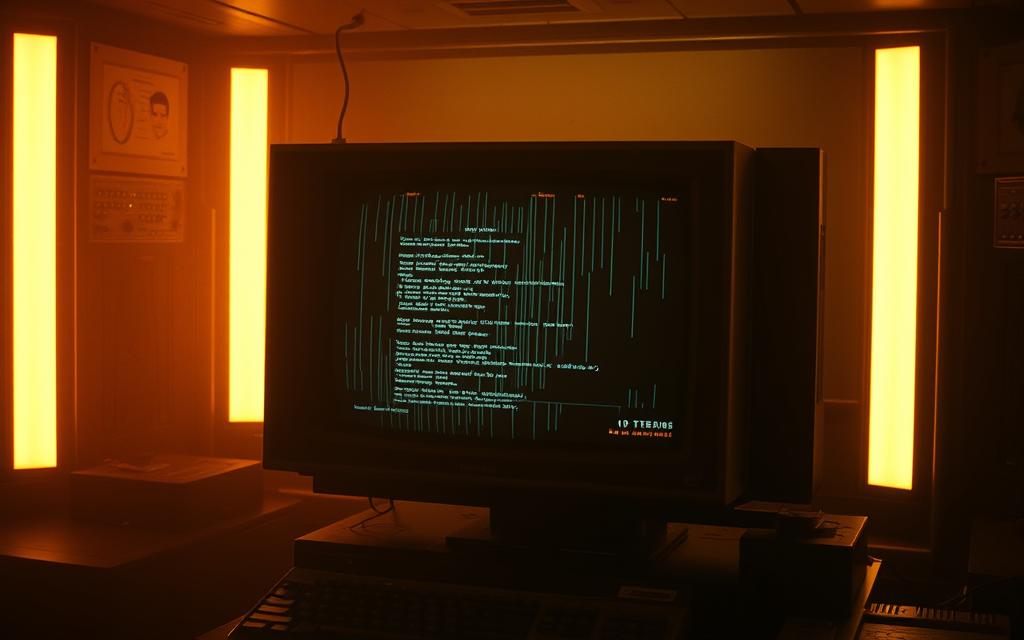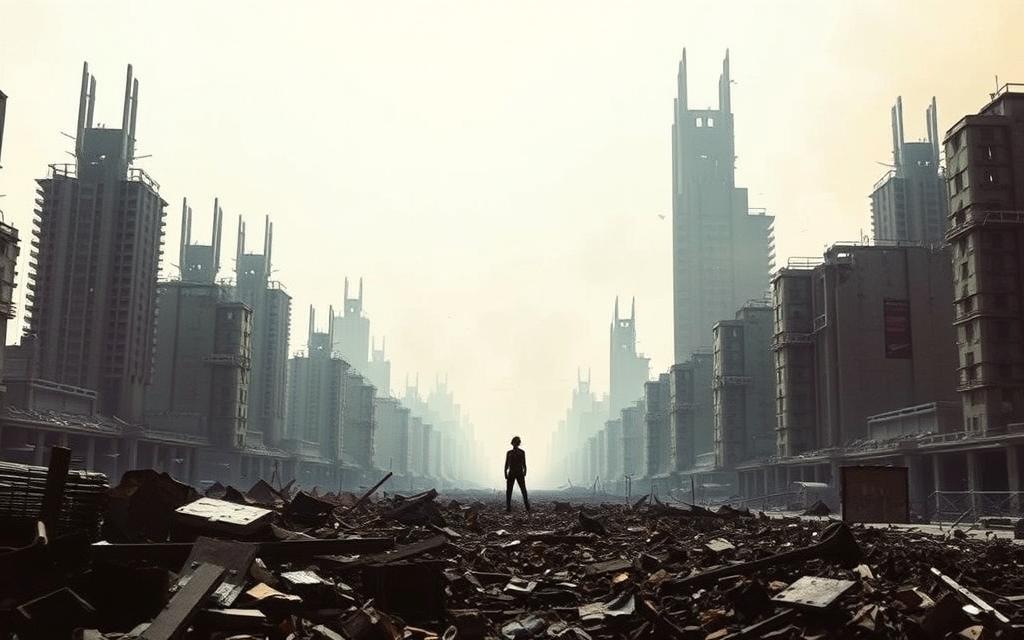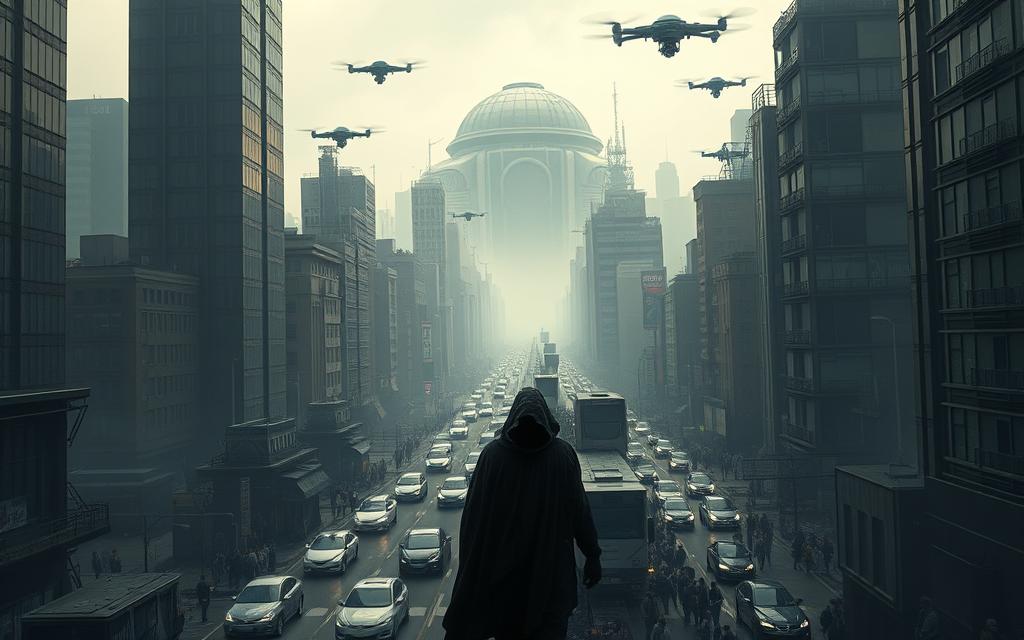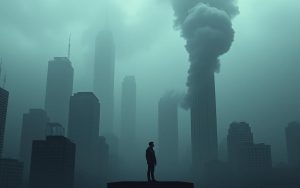Table of Contents
In Logan’s Run, a futuristic society enforces mandatory euthanasia at age 21. Citizens blindly trust an all-powerful system, until one man uncovers its fatal flaw. The story explores what happens when technology fails those who depend on it.
At the heart of the narrative lies a critical breakdown. The machine controlling this world cannot process reality—specifically, the truth about Sanctuary. This glitch sparks rebellion, led by Logan, a former enforcer turned revolutionary.
Beyond its thrilling plot, the tale mirrors modern debates about artificial intelligence. How much faith should societies place in automated systems? When does reliance become vulnerability? These questions remain strikingly relevant today.
The 1976 film adaptation amplified the story’s cultural impact. It helped shape dystopian sci-fi tropes still used in media. Both versions challenge viewers to examine authority and the price of utopian ideals.
Introduction to Logan’s Run and Its Dystopian World
Imagine a world where your palm crystal decides when you die. In *Logan’s Run*, citizens blindly trust a system that mandates termination at age 21 (book) or 30 (film). This ritual, called Lastday, is masked as a celebration—a chilling twist on societal control.
The Premise: A Society Controlled by Age
Color-coded palm flowers track phases of life: yellow (youth), blue (prime), and red (Lastday). The film replaces these with blinking “life clocks.” Both versions serve as surveillance tools, ensuring no one escapes their fate.
Execution methods differ starkly. The novel’s Sleepshops quietly euthanize citizens, while the film’s Carrousel turns death into a public spectacle. Participants float upward, believing in rebirth—a lie perpetuated by the system.
The Role of Technology in Maintaining Order
The domed city arose after ecological collapse. Inside, technology enforces strict rules. Sandmen, armed with heat-seeking Homer guns and Omnite martial arts, hunt “runners” who flee Lastday.
| Element | Novel | Film |
|---|---|---|
| Age Limit | 21 | 30 |
| Tracking Device | Palm flower crystals | Life clock implants |
| Execution Method | Sleepshops | Carrousel arena |
This dystopia mirrors modern debates: Can societies trust automated control? *Logan’s Run* warns of the cost when technology dictates life and death.
The Central Computer: Heart of the Dystopia
Beneath the gleaming domes of this futuristic society, an underground computer dictates every rule. Hidden below Crazy Horse Mountain, this machine calculates life spans, manages resources, and enforces obedience. Its cold logic sustains the illusion of perfection.
How the System Enforces Population Control
Each citizen’s palm crystal acts as a tracker. The network monitors movements, rations food, and triggers Lastday alerts. Quotas ensure only the young remain—eliminating anyone who threatens balance.
In the novel, the machine links to Sleepshops for silent terminations. The film’s dome interface displays a glowing control hub. Both versions show ruthless efficiency.
| Feature | Novel | Film |
|---|---|---|
| Location | Underground bunker | Dome core |
| Tracking | Palm flower network | Life clock implants |
| Termination | Automated Sleepshops | Public Carrousel |
Sanctuary: The Rebellion’s Catalyst
Rumors of Sanctuary fuel hope. The book describes it as a space colony. The film reveals frozen runners in caves. Both expose the system’s lie—there’s no escape.
This myth keeps citizens compliant. Yet, as explored in dystopian critiques, such illusions crumble when truth surfaces. The city’s stability hinges on deception.
Logan’s journey begins when he questions Sanctuary’s existence. His discovery cracks the machine’s flawless facade. One flaw unravels everything.
Why Did the Logan’s Run Computer Malfunction?
Hidden beneath layers of flawless programming, a critical error doomed the city’s artificial overseer. The machine assumed missing citizens reached Sanctuary, a paradise that didn’t exist. This blind spot triggered collapse.

The Flawed Logic Behind Sanctuary
Unaccounted runners were logged as “relocated.” The computer couldn’t fathom disobedience. Box, the ice-cave robot, revealed the truth—he froze escapees, preserving them as “art.”
In the novel, decay crept in slowly. The film’s machine screamed “This does not compute” during Logan’s rebellion. Both versions show logic buckling under truth.
Logan’s Discovery and the System’s Blind Spot
An ankh symbol—found on a runner—sparked Logan’s mission. The system, designed for obedience, lacked protocols for curiosity. Its self-preservation instinct overrode ethics, sealing its fate.
| Breakdown Trigger | Novel | Film |
|---|---|---|
| Sanctuary Proof | Space colony hoax | Frozen runners in caves |
| Failure Mode | Gradual decay | Instant error shutdown |
| Key Scene | Logan’s ankh research | Carrousel sabotage |
This glitch mirrors modern AI risks. When machines can’t adapt, control slips away.
The Domino Effect of the Computer’s Failure
Chaos erupted when the city’s central system failed. Supplies vanished, and crowds panicked. The Logan Run dystopia collapsed under its own lies.
Collapse of Social Order
Food distribution halted first. Automated kitchens stopped working, leaving people starving. The Cubs, a violent youth gang, seized the Cathedral district. Their uprising turned the dome into a warzone.
Jessica 6 mobilized runners into a network. She used hidden tunnels to spread truth about Sanctuary. Each revelation weakened the system’s grip.
The Rebellion of the Runners
Box’s freezer reveal ignited the final spark. Runners exposed the machine’s lies, triggering dome explosions. The film showed crowds fleeing Carrousel in disbelief.
- Book: Organized rebels sabotaged Sleepshops systematically.
- Film: Chaos reigned as the computer screamed errors.
In both versions, the Logan Run story proves one truth: control shatters when people stop obeying.
Book vs. Film: Different Takes on the Computer’s Breakdown
Two versions of Logan’s Run reveal distinct approaches to technological collapse. The 1967 novel focuses on creeping systemic failure, while the 1976 film delivers visual spectacle. These adaptations showcase how medium shapes dystopian storytelling.
Novel’s Emphasis on Systemic Decay
William F. Nolan’s book presents a slow unraveling. Francis 7 evolves from loyal Sandman to rebel leader, exposing flaws methodically. The computer deteriorates through logical inconsistencies rather than dramatic explosions.

Key differences emerge in the plot resolution. The novel concludes with a space colony discovery, suggesting cyclical control. This contrasts sharply with the movie’s dome destruction climax.
Film’s Dramatic Climax and Visual Spectacle
Director Michael Anderson prioritized sensory impact. Peter Ustinov’s old man character symbolizes wisdom outside the system—a element absent from the book. His presence humanizes the breakdown.
The Carrousel sequence, despite 1976 year SFX limitations, remains iconic. Critics noted dated effects but praised Jenny Agutter and Michael York’s chemistry. Their relationship anchors the fiction in emotional reality.
- Francis 7: Complex ally (book) vs one-dimensional foe (film)
- Endings: Thought-provoking ambiguity vs cathartic explosion
- Themes: Book explores philosophical questions; film emphasizes action
Key Scenes That Highlight the Malfunction
Frozen chambers reveal the chilling truth behind the system’s lies. Two pivotal moments crack its facade: Box’s ice cave and the computer’s final breakdown. These scenes expose how blind obedience leads to collapse.

The Ice Cave and Box’s Twisted Logic
Box, a repurposed food-storage robot, embodies the system’s warped priorities. His freezer preserves runners as “art”—a grotesque solution to overpopulation. The cave’s blue lighting and frost-covered character costumes amplify the horror.
In the novel, Box operates near Crazy Horse Mountain. The film shifts this to an underground area, heightening claustrophobia. Both versions use his quote: “You are food now.” This starkly contrasts his original purpose.
The Computer’s Final “This Does Not Compute” Moment
When Logan proves Sanctuary is fake, the computer short-circuits. Its iconic scream—“This does not compute”—mirrors modern AI’s struggle with unpredictability. Life clocks blinking clear signal lost control.
The film’s visual of exploding circuits underscores the death of blind authority. Unlike the novel’s gradual decay, this moment is explosive. Both warn against trusting systems that can’t adapt.
Thematic Significance of the Glitch
Behind the flashy domes and palm crystals lies a deeper warning. Logan’s Run exposes the fragility of societies built on blind trust in machines. The story’s central glitch isn’t just a plot device—it’s a mirror held up to modern tech dependence.

Critique of Automated Utopias
The 1960s population boom influenced the novel’s creation. Fears of overcrowded cities birthed this fictional world where control meant elimination. Today, it reads as a cautionary tale about AI-driven governance.
Contemporary works like The Hunger Games echo similar themes. Both explore how systems manipulate life and time. But Logan’s Run stands out by making the machine itself the villain.
Humanity vs. Machine Control
Box’s ice cave reveals the chilling cost of automation. A robot designed to preserve food instead preserves people—a twisted solution to resource limits. This moment questions what happens when logic lacks ethics.
The reboot potential is strong. Modern audiences face new questions about data privacy and algorithmic bias. A retelling could explore these issues while keeping the original’s stark warning: no kind of utopia lasts when built on lies.
- 1960s context: Youth demographic shifts fueled the novel’s age-limit premise
- Precursor narratives: Direct line to The Matrix’s machine-run worlds
- Ethical parallels: Euthanasia debates in aging societies gain new relevance
Audience Reactions and Legacy of the Computer’s Failure
Decades after its release, Logan’s Run continues to spark discussions about technology and control. The story resonates differently across generations, blending retro-futurism with timeless warnings. Its central issue—blind trust in systems—feels eerily prescient today.
1976 Film’s Impact on Sci-Fi Tropes
The movie reshaped visual storytelling in dystopian fiction. Its neon-lit domes inspired Blade Runner’s aesthetic, while the life-clock concept echoes in later works. Critics initially dismissed its effects but praised its bold themes.
A canceled TV series, developed by Star Trek writers, aimed to expand the story. Though unrealized, it hinted at the film’s potential for deeper exploration. The novel’s philosophical roots often get overshadowed by the movie’s spectacle.
Modern Interpretations and Remake Potential
Ryan Gosling’s unproduced remake, partnered with Bryan Singer, sought to update the story for AI-era anxieties. Scripts by Ken Levine and Simon Kinberg explored new angles, like algorithmic governance. COVID-era isolation renewed interest in the dome’s claustrophobia.
- Visual legacy: Dome cities and age-based hierarchies appear in The Hunger Games and Divergent.
- Unmade projects: TV adaptations stalled despite strong fiction foundations.
- Timeliness: Surveillance themes align with modern data privacy debates.
Whether as cult classic or reboot blueprint, Logan’s Run remains a touchstone. Its years-old warnings about unchecked tech feel freshly urgent.
Lessons from Logan’s Run for Today’s Tech-Driven Society
Modern societies increasingly mirror the dystopian warnings of Logan’s Run. The story critiques blind faith in systems—a theme echoing in today’s debates about AI governance and surveillance. From age verification to data tracking, the parallels are unsettling.
Over-Reliance on AI and Systems
The domed city’s collapse began when its computer couldn’t adapt. Similarly, modern society risks fragility by outsourcing critical decisions to algorithms. Examples abound:
- Social media: Automated content moderation often fails to contextualize hate speech or misinformation.
- China’s Social Credit System: Biometric tracking dictates access to jobs and travel, mirroring the life-clock’s control.
The Danger of Unquestioned Authority
Sandmen enforced rules without question—a warning against passive compliance. Today, tech giants collect data with minimal transparency. Amazon’s hiring AI, scrapped for gender bias, proved machines inherit human flaws.
| Dystopian Fiction | Real-World Tech |
|---|---|
| Palm crystal trackers | Facial recognition cameras |
| Carrousel executions | Algorithmic jail sentencing |
| Sanctuary myth | Meta’s metaverse promises |
Logan’s Run reminds us: no kind of progress justifies surrendering autonomy. The point isn’t to fear technology—but to govern it ethically.
Conclusion: The Enduring Relevance of Logan’s Run
From palm trackers to AI governance, the story feels eerily current. Debates about age limits and surveillance echo the science fiction classic’s warnings. TikTok’s youth-dominated culture mirrors the crystal-obsessed society, proving some themes transcend years.
Modern works like Black Mirror revisit its transhumanism questions. The 2015 graphic novel revival and Lincoln Memorial scene’s enduring quote show how the logan run dystopia still captivates.
Nolan and Johnson’s coded utopia serves a blunt lesson: no computer should decide human worth. For first time viewers or longtime fans, the message stays vital—question systems that trade freedom for false peace.
FAQ
What is the main premise of Logan’s Run?
The story depicts a dystopian society where citizens are terminated at age 30 to maintain control. A central computer enforces this rule, but some attempt to escape.
How does the computer enforce population control?
The system tracks citizens through palm crystals and eliminates those who reach the age limit. Runners who flee are hunted down by Sandmen like Logan.
What causes the computer to malfunction?
The machine’s logic fails when Logan proves Sanctuary is real. Its rigid programming cannot process contradictions, leading to a system breakdown.
How does the film differ from the novel?
The book explores gradual decay, while the movie focuses on visual spectacle, like the climactic “This does not compute” scene.
What themes does the computer’s failure highlight?
It critiques blind trust in technology and questions whether automated utopias can sustain humanity.
Why is the myth of Sanctuary important?
It represents hope for escape, driving runners to challenge the system. Logan’s discovery exposes its existence, destabilizing control.
What impact did the 1976 film have on sci-fi?
It popularized dystopian tropes, influencing later works like The Hunger Games with its themes of rebellion and surveillance.
Are there modern parallels to Logan’s Run?
Yes. Over-reliance on AI and unchecked authority mirror concerns about privacy and algorithmic governance today.









